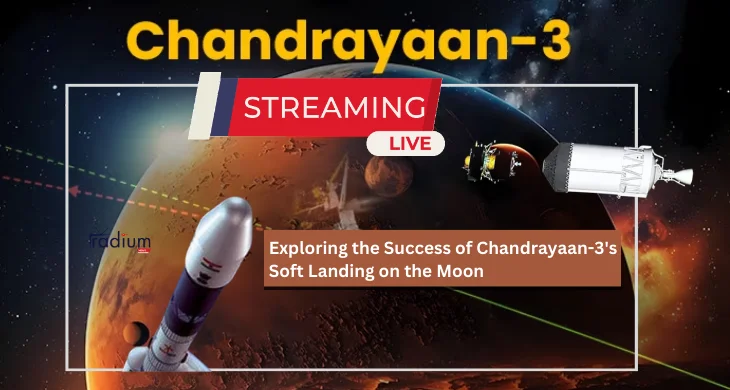Introduction
Chandrayaan-3’s triumphant soft landing at the Moon’s South Pole marks an extraordinary achievement in India’s space exploration endeavors. This milestone is not only a testament to technological innovation but also a leap towards unraveling the mysteries of the lunar surface in a region less explored. As we delve into this success, we uncover the challenges, significance, and scientific discoveries that this achievement brings to the forefront.
Technological Triumph
Chandrayaan-3’s soft landing stands as a testament to India’s remarkable technological prowess. This triumph underscores the nation’s ability to conceive, design, and execute intricate space missions, solidifying its position as a prominent player in the global space exploration arena. It’s a testament to innovation and engineering excellence.
Precision Engineering
The success of Chandrayaan-3 highlights the critical role of precision engineering and meticulous planning. Achieving a controlled and gentle lunar touchdown demands the synchronization of cutting-edge technology, calculations, and expertise. This accomplishment showcases India’s capability to navigate the complexities of space exploration with finesse and accuracy.
Global Recognition
Chandrayaan-3’s triumphant soft landing amplifies India’s standing in the global space arena. The success solidifies the nation’s reputation as a formidable contender in space exploration, Garnering international recognition. India’s contributions to space technology & scientific advancement are acknowledged, underscoring it’s pivotal role in shaping the future of space exploration.
Historic Milestone
Chandrayaan-3’s accomplishment etches a historic milestone in India’s space journey. This achievement signifies a new chapter in the nation’s persistent exploration of the Moon, a testament to India’s commitment to unraveling celestial mysteries. The success amplifies the nation’s legacy in space exploration and inspires future scientific quests.
Data Collection
Chandrayaan-3’s landing yields invaluable data for lunar science. The information collected deepens our comprehension of the Moon’s geology, surface characteristics, and potential historical evolution. This dataset fuels scientific progress, opening windows into the Moon’s past and present, while propelling humanity’s exploration of our celestial neighbor.
Team members
S Somanath, ISRO Chairman
Ritu Karidhal Srivastava, Senior Scientist – ISRO
P Veeramuthuvel, Project Director, Chandrayaan-3
S Unnikrishnan Nair, Director, Vikram Sarabhai Space Centre (VSSC)
A Rajarajan, chairman, Launch Authorisation Board (LAB)
M Sankaran, Director, U R Rao Satellite Centre (URSC)
FAQ’s
Q1 What is Chandrayaan-3?
Chandrayaan-3 is India’s third lunar exploration mission, designed to study and explore the Moon’s surface and gather scientific data.
Q2: What is the reason behind Chandrayaan-3’s targeted landing on the South Pole?
Ans: Chandrayaan-3’s strategic choice of the lunar South Pole as its landing site is driven by the quest to uncover lunar water resources. Extensive studies and remote sensing data have indicated that the craters within this polar region are particularly promising in terms of water presence, motivating this mission’s focus.
Q3: How many nations have achieved successful soft landings on the moon?
Ans: The Soviet Union, the United States, and China stand as the exclusive trio to have accomplished gentle landings on the lunar surface. With optimism, India aspires to join this esteemed group following today’s endeavor.
Q4: Is Chandrayaan-3 benefiting from Chandrayaan-2?
Ans: As confirmed by ISRO, the Chandrayaan-2 orbiter, stationed in lunar orbit, has successfully established communication with the rover-carrying lander module Vikram of Chandrayaan-3. This development holds significance as it establishes multiple reliable connections between the lander module and ISRO’s central command.
Q5 What were the primary technological components employed in achieving the successful soft landing?
The successful soft landing of Chandrayaan-3 hinged on key technological components: precision landing engines for controlled descent, navigation systems for accurate targeting, terrain mapping for hazard assessment, robust communication for real-time monitoring, autonomous algorithms for adaptive decision-making, and thermal protection for lunar conditions.
Q6 In what ways does Chandrayaan-3 distinguish itself from its earlier missions?
Chandrayaan-3 sets itself apart through its singular focus on achieving a soft landing. Unlike its predecessors, its mission scope centers on landing technology and data collection, emphasizing a controlled descent onto a targeted lunar site, marking a shift from orbiters and rovers to gather specific surface insights.
Q7 Was there a successful landing of Vikram on the Moon?
The Vikram lander’s previous mission, Chandrayaan-2, experienced challenges during its landing attempt and lost communication just before touchdown. As of that mission, Vikram’s landing was not successful. However, Chandrayaan-3 aims to achieve a successful soft landing on the Moon’s surface.
Q8 What are the key instruments onboard Chandrayaan-3?
The specific instruments carried by Chandrayaan-3 will be designed to analyze the lunar surface, measure geological properties, and gather data about the environment.
Stay informed with the latest updates and breaking news, brought to you by radiumnews.

